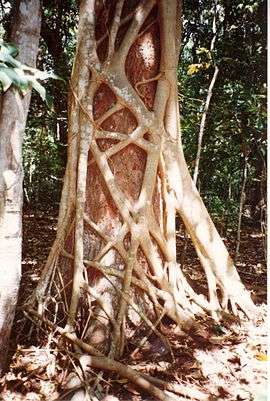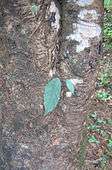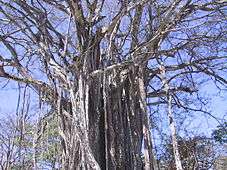Strangler fig
Strangler fig is the common name for a number of tropical and subtropical plant species, including some banyans and unrelated vines, including among many other species:
They all share a common "strangling" growth habit that is found in many tropical forest species, particularly of the genus Ficus.[1] This growth habit is an adaptation for growing in dark forests where the competition for light is intense. These plants begin life as hemiepiphytes, when their seeds, often bird-dispersed, germinate in crevices atop other trees. These seedlings grow their roots downward and envelop the host tree while also growing upward to reach into the sunlight zone above the canopy.[2][3]
An original support tree can sometimes die, so that the strangler fig becomes a "columnar tree" with a hollow central core.
Gallery
| A strangler fig sapling starts to grow on a tree, roots can be seen |
| Old strangler fig in the final stage, Costa-Rica, Pacific |
| A strangler fig. The supporting tree, now dead can also be seen. Photo from Kannavam forest |
| A columnar tree formed by a strangler fig after the central tree has died. The tree is hollow as seen in this photograph from below. |
|
References
- ↑ Zhekun, Zhou & Michael G. Gilbert (2003) Flora of China (Moraceae) 5: 21-73. hua.huh.harvard.edu
- ↑ Serventy, V. 1984. Australian Native Plants. Victoria: Reed Books.
- ↑ Light in the rainforest 1992 Tropical topics. Vol 1 No. 5, epa.qld.gov.au
External links




